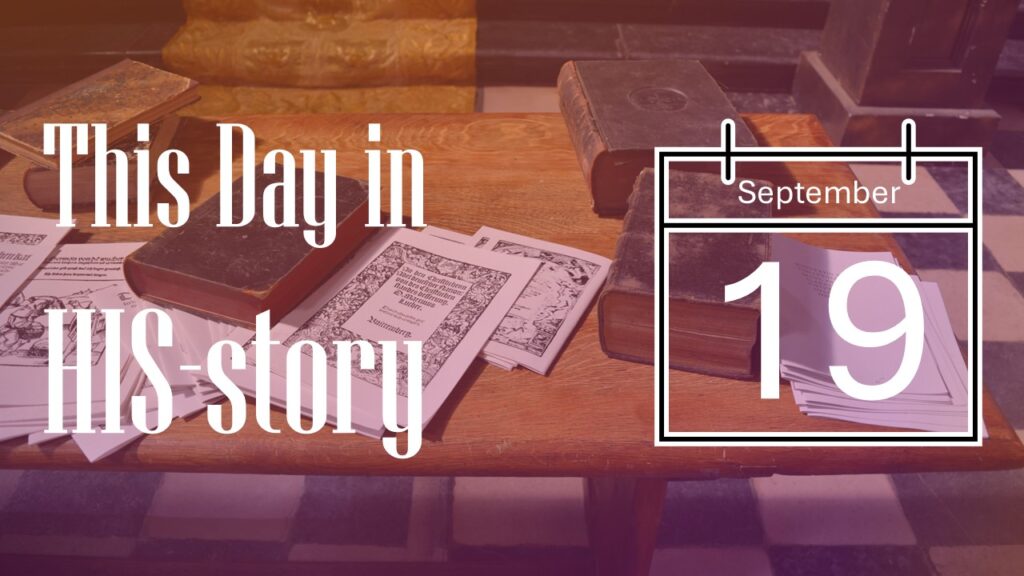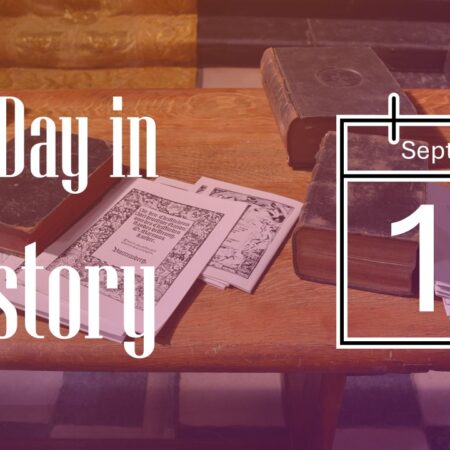
1853
ON THIS DAY, 19 SEPTEMBER 1853, the Dumfries, a small sailing ship, left Liverpool. Aboard was one passenger—James Hudson Taylor, bound for China. His mother came to see him off, knowing it would be years before she would see him again—if ever.
Never shall I forget the cry of anguish wrung from [my] mother’s heart. It went through me like a knife. I never knew so fully until then, what “God so loved the world” meant. And I am quite sure my precious mother learned more of the love of God for the perishing in that one hour than in all her life before.
Five and a half months passed before Dumfries finally docked in Shanghai. In those months, the little ship nearly wrecked at least twice. The second time, when currents drove it toward a reef during a calm, Taylor and three other Christians prayed. Two of those praying Christians had been won by Taylor’s persistent witness. Taylor went on deck and asked the godless mate to unfurl sail, saying wind was coming and he needed to be prepared. The mate cursed, but a puff came at that moment, and they soon had enough wind to clear the danger.

Taylor’s subsequent story is well-known. After a rough start, he mastered Mandarin and began to preach. When he was unable to make his mission board in England understand the situation and needs in China, he graciously withdrew and formed the China Inland Mission, a work based entirely on faith. He adopted Chinese dress so that western costume would not impede his work. And knowing that the Chinese resented foreigners, he aimed from the start to create a Chinese church run by the Chinese. He had moments of despondency and once even came close to despair, but persisted and saw an increase in workers and in fruit.
Many predicted disaster when he sent single women in pairs to work in distant provinces. They succeeded beyond expectation and without disaster. By his death, the mission had thousands of converts and two hundred and five missionaries.
According to Leslie T. Lyall, the secret of Hudson Taylor’s life and ministry could be summed up in four simple propositions: “There is a living God. He has spoken in His Word. He means what he says. And He is willing and able to perform what He has promised.”
1874
Attending a prayer meeting in Dunedin, New Zealand, Florence Young is terrified at the thought of Christ’s Second Coming until suddenly she realizes that the promise of Isaiah 43:25 applies to her: “I, even I, am he that blotteth out thy transgressions for mine own sake.” Thereafter she is able to serve the Lord with gladness, and eventually will be instrumental in founding and operating the South Sea Evangelical Mission.

1905
On this evening, September 19, 1905, sixty-year-old “Dr.” Thomas Barnardo complained that his head felt heavy. Asking his wife to allow him to rest it on her for a moment, he slipped out of this life. 1,500 boys appeared at his funeral along with many poor people and rough men who sobbed openly. For Thomas had been a friend to neglected children. At his death, about 8,000 were living in homes he had founded.

Born in Ireland, Thomas was a restless boy who bored easily and would not stick to his lessons. Failing his exams, he had to leave school at sixteen and was apprenticed to a wine merchant. That year he was converted to evangelical Christianity. At once, he began visiting homes telling others about the gospel and teaching the Bible in “ragged schools” (charity schools for impoverished children). He joined the Plymouth Brethren.
Hearing about the work of Hudson Taylor in China, he was fired with enthusiasm for it and found the means to attend medical school in London so that he could prepare for the mission field. While living near the hospital, he continued slum work. His message was not always welcomed: once he had a couple of his ribs broken by opponents and at other times he was roughed up in other ways.
But Thomas was persistent. Once again he donated time to work in a ragged school. It was after one evening’s lesson that he met (according to his account) a young fellow named Jim Jarvis who was evidently reluctant to leave. It turned out that Jim had no home. “Well, but where did you sleep last night?”
“Down in Whitechapel, sir, along the Haymarket in one of them carts as is filled with hay; and I met a chap and he telled me to come here to school, as perhaps you’d let me lie near the fire all night.”
Although still attracted toward his goal of becoming a missionary in China, Thomas increased the scope of his work among London’s neglected youth. In response to an article he wrote, he was offered money to continue his London work. Eventually he gave up the China plan and developed his successful East End Juvenile Mission among neglected young people.
This included schools, meal programs, a job agency, homes for boys, homes for girls, and homes for the feeble-minded. An innovative marketer, Thomas came up with original ways to raise funds. One was before and after photographs of every child who entered his homes. These were printed and sold in packs. Another was to form a league of middle class youth to raise contributions for his schemes. Generally his ideas outran his funding, but he would not obey the limits placed on him by his boards. However, he knew how to milk stories like Jim’s for all they were worth. The details of his stories changed according to his needs.
Not all of Thomas’ methods would stand muster today. For example, he shipped large numbers of children to Canada and Australia. Although he meant well, many suffered severely in the relocation.
Wrapped up in his noble cause and always in need of more funds to spread the work, Thomas left himself open to charges of dishonesty. He inflated his figures and altered stories. Accusations were proven against him (but not in court). They seem to have barely fazed him and he struggled for the poor until the day of his death. Thousands owed a better existence to him.
1955
How’d you like to go looking for your neighbors?” Nate Saint had just flown into Arunjo on his weekly run from his permanent base at Shell Mera and was talking to Ed McCulley. The weather was favorable for searching for the elusive “Aucas” (Woadani). The missionaries wanted to share the gospel with them. Months earlier, Nate had flown over the last place they were known to have lived, but found no traces of them.

Ed eagerly boarded the “modern missionary mule” as Nate liked to call his little yellow missionary plane. The two lifted off into crystal clear air and began their hunt above the Ecuador jungle, searching for signs of Auca houses among the trees, especially along rivers. Some of the villages which had been reported earlier had hugged streams.
It seemed as if the hunt that began on this day, September 19, 1955, would prove futile like all others. Gas was running low and it was essential to turn back soon. But then Nate noticed a blemish, “barely discernible in the jungle.” He headed for it. It grew and they saw it was a clearing with manioc plants growing. In the few minutes remaining to them, they spotted fifteen more clearings and a few houses. Elated they headed home. They had found the Aucas.
Excitement was intense because the men had long hoped to contact these sturdy forest dwellers who fiercely resisted all efforts to subdue them, killing many who ventured into their territory. Ten days later, ferrying men and goods to another station in four flights, Nate deliberately flew different routes each way, zigzagging to bring as much territory under his plane as possible. On the third flight he spotted Auca dwellings barely fifteen minutes by air from the Arunjo station.
On October 1st, bad weather kept Ed from going back to Arunjo. Ed, Nate and two other missionaries gathered at Shell Mera and talked into the wee hours of the morning, huddled over maps and trying to establish the best strategy for reaching the Auca. How could they show them they came in peace and not in hostility?
Although they badly wanted prayer cover, the men decided to say as little as possible to the outside world. Government powers or secular forces might try to one-up them with armed expeditions. Nate and the other missionaries hoped to prevent that. They wanted no interference in winning Auca souls.
The outcome is well known. Nate Saint, Ed McCulley, Jim Elliot, Roger Youderan and Pete Fleming made contact with the Aucas. They dropped gifts to them from the air and landed on a beach where they spoke with members of the tribe. On January 6, 1956 all five were massacred in an ambush. Later, through the efforts of the widows, the Aucas discovered the meaning of Christian love and forgiveness and were converted to Christ.
1971
Death of William F. Albright, American Methodist archaeologist who had excavated the biblical sites of Gibeah, Bethel, and Petra and did much to substantiate the accuracy of the Bible.

